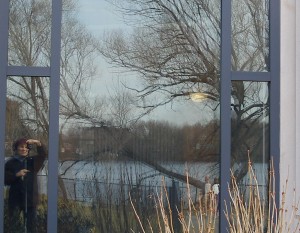 Apologies, once again, for the long absence….but this time I have a good excuse. I’ve moved to the country!
Apologies, once again, for the long absence….but this time I have a good excuse. I’ve moved to the country!
Actually, I still live in Cambridge–but after 29 years in that lofty perch overlooking the Cambridge Common I now live in a new house–just across from Fresh Pond Reservoir.
New home, new neighborhood, new outlook on life–less than a mile and a quarter from Harvard Square.
A few observations:
When I told people I was moving after so many years in the same building, I usually got one of the following responses:
(1) Why are you moving NOW? (As if I should die in a place I NEVER liked. Too little space, too much noise and no parking!)
and
(2) That’s wonderful. Now you have a good reason to get rid of your stuff. (Huh? The main reason I”m moving is that I want more ROOM for my stuff).
The new place is gorgeous-three floors, a garage, a basement, big windows, light…and just a 10-minute bike ride from my favorite morning coffee haunt. There’s a grocery store nearby, a gym, a Chinese restaurant…I have nice neighbors who like gardening so much that they bought some plants that they take care of in my front yard. When you walk down the street, people actually smile and say “hello”
Yesterday, my friend Susan and I walked around the reservoir. On a Sunday afternoon, it felt rather like a Parisian promenade, except that it’s 2.2 miles in circumference and there were many, many dogs. Part-way round, theCity of Cambridge Water Department is renovating…that’s not what they call it…but setting up ramps for people disabilities, a walkway out over the water and something called a vernal pond–which, I now know, courtesy of Susan and Wikipedia, is a temporary or “emphermeral” pool.
These pools, devoid of fish, are dry for at least part of the year but when filled (usually in the Spring) they teem with life such as frogs, toads, salamanders, daphnia and fairy shrimp–the last of which are often used to decisively define a vernal pool.
Close by the pool, we met MWRA Ranger Jean–who, with a colleague, was posting a sign explaining all of the above. She welcomed us to the neighborhood and told us to say hi to people and dogs–who, along with the golfers, tennis and base ball players and my neighbors, make up quite a friendly community, and a welcoming crowd.
—-Anita M. Harris
Anita Harris is president of the Harris Communications Group, a strategic marketing communications and public relations firm located in Cambridge, MA.










 Newspapers have long kept tabs on the changing world–but have themselves been slow to modernize. To flourish these days,
Newspapers have long kept tabs on the changing world–but have themselves been slow to modernize. To flourish these days, Through the Looking Glass is a 40-year retrospective of the Washington State artist’s blown glass sculptures–such as a boat containing thousands of glass flowers, fantastical forests, sculptures based on South American basketry–which took us out of our doldrums and got our imaginations flowing and reminded us that we can each create worlds of our own.
Through the Looking Glass is a 40-year retrospective of the Washington State artist’s blown glass sculptures–such as a boat containing thousands of glass flowers, fantastical forests, sculptures based on South American basketry–which took us out of our doldrums and got our imaginations flowing and reminded us that we can each create worlds of our own.
 In
In 

